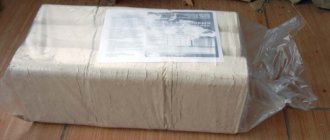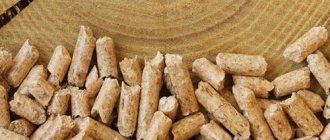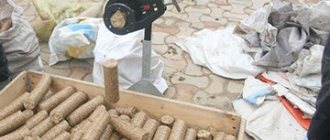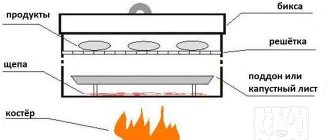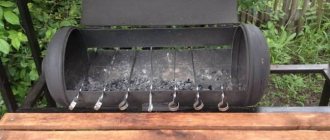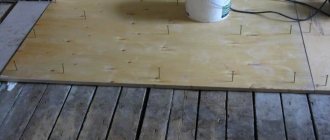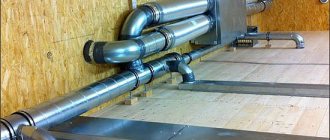The issue of country heating is becoming more acute every year: everything is becoming more expensive, both firewood, coal or peat, and their delivery. Meanwhile, potential fuel is literally “lying” under our feet. We can use shavings and sawdust, dry leaves and straw, the husks of all grain crops, wood chips and branches cut off while tending the garden, unusable boards - all this is quite suitable for making fuel briquettes with your own hands. And if you come to an agreement with the manager of a nearby forestry enterprise or park, or make friends with the owner of a sawmill, you will have plenty of material for briquettes for personal use.
Homemade sawdust briquettes are an excellent fuel
For reference
It is impractical and even pointless to send wood waste in its natural form to a furnace or boiler. Their friability leads to the fact that burnout occurs in the shortest possible time and is accompanied by weak heat transfer. In addition, a significant part of the sawdust spills from the grate into the ash pan, which reduces efficiency and increases consumption. Sawdust fuel briquettes do not have all these disadvantages. From an economic point of view, it is unreasonable not to use waste, which is available in abundance at the dacha, for one’s own purposes.
You can use shavings, straw, hay, and dry leaves as raw materials.
Newspaper
Not very modern, but very reliable, free and always at hand if you forget lighter fluid and dry alcohol. Newspapers are rolled into a tube, some coals are poured onto them, and the structure is set on fire on both sides. The coals flare up and the rest is added to them. You wait until the coals warm up and turn into gray ash, and fry. It's simple.
The main thing is not to use glossy paper for lighting; the front and back pages of newspapers are often made from it. And magazines are not very suitable either.
Proper meat, simple marinade. Current advice for barbecue makers Read more
Advantages of do-it-yourself fuel briquettes
Homemade fuel has many advantages.
- Almost any waste, except food and artificial, is suitable as a raw material for fuel briquettes. They can be injected with coal dust, which is considered an inevitable loss.
- Fuel briquettes have an impressive burning time of up to 4 hours. And throughout this entire period heat will be generated.
- It is quite possible to make your own fuel briquettes. Moreover, such production does not require significant initial investments.
- When burning fuel briquettes, virtually no smoke is released.
- Briquettes made from sawdust and other wood waste are extremely environmentally friendly, because only natural ingredients are used to make fuel briquettes.
- Such fuel is practical and economical: its cost when produced independently is several times lower than the same amount of coal or firewood, and the energy output is the same, or even higher. In addition, ash from sawdust briquettes and other wood waste is an excellent fertilizer for cultivated plants.
True, the production of fuel briquettes from sawdust requires some time and physical effort. On the other hand, in a country house there is always free time. And work, as we know, ennobles.
Fuel briquettes are multifunctional
DIY making
Residents of Chinese villages make their own coal briquettes . They take rubber basins and mix the sticky mixture. They form cubes from it using a press on a long handle. After giving the necessary shapes, the materials are dried in the sun. As soon as they are ready, they are placed in a Taganka oven and set on fire.
You can take sawdust and shredded newsprint. This raw material will need to be mixed well. A drill with a special attachment is best suited for this. Next, the resulting mass must be placed in a mold, compacted and covered with a lid. After this, they are pressed using special equipment and dried in the sun.
Sawdust briquettes can be used for heating warehouses, industrial premises, residential premises, and railway rolling stock. This is also a popular option among summer residents and tourists who use European firewood to light barbecues and fires.
Scope of application
Sawdust briquettes have a fairly wide functionality. This fuel can be used:
- for heating a residential building. Due to their compactness, briquettes made from wood raw materials are suitable for fireplaces, stoves, and solid fuel boilers;
- when heating baths and saunas, if your main house is heated in some other way. Briquettes ideally suit all environmental conditions;
- on picnics. They are an excellent alternative to coal and firewood. Moreover, they can boast of a remarkable property: when fat gets on a hot briquette, the latter does not ignite and does not smoke.
By the way, sawdust briquettes should probably be recommended for cooking in closed spaces: there is no burning smell, and the dish is fried extremely evenly.
A little theory
Before you start making homemade briquettes, you should familiarize yourself with the stages of their industrial production. This will help you avoid making mistakes when creating your own fuel. The algorithm of actions in production is as follows.
- The raw materials are crushed to approximately the same particle size of the starting material.
- The sawdust is dried; The humidity level should drop to 10 percent.
- Next, either a hydraulic press or an extruder is used, depending on the method of forming the fuel, which is preferred in production.
- At the final stage, the finished product is packaged to prevent it from absorbing moisture from the atmosphere.
In the production of sawdust briquettes, no adhesive material is used. Under pressure from the press, when the raw material spontaneously heats up, lignin is released from the wood, which prevents the disintegration of the finished product, maintaining its given shape.
Features of making briquettes with your own hands
The equipment available for making fuel at home does not allow the press to press the raw material with enough force to cause lignin to begin to be released. Therefore, it will not be possible to make a briquette without binders in handicraft production.
In addition, the costs of drying equipment will make the finished product unprofitable - it will be cheaper to buy traditional coal and firewood. On the other hand, this inconvenience somewhat simplifies the production of briquettes with your own hands: you can skip the drying step while complying with a number of technological requirements. But a new difficulty appears: after you have passed the raw materials through the press for fuel briquettes with your own hands, you need to place the finished product to dry. That is, provide space under a canopy in the summer or a room with low humidity and sufficient temperature in other seasons.
However, real masters of the fuel business are engaged in the production of fuel briquettes exclusively during the summer season - and in winter they are actively consumed.
Do it yourself: pallets from waste paper
Do not rush to throw away old newspapers; with special treatment, they can easily turn into kindling for a fire or even firewood. Fuel briquettes made from waste paper were tested in field conditions by one of the tourists, who came up with a method for their manufacture and impregnation. With such fuel, even in the forest you won’t have to look for dry wood chips or pine cones for your mini-pinch stove.
Browse products for inventors. Link to the store.
A video tutorial in three parts will teach you the art of converting waste raw materials into effective fuel.
The first video introduces firewood from newspapers. What it is?
Next, watch how kindling made from waste paper burns.
DIY electronics in a Chinese store.
Finally, how to make fuel briquettes at home.
In conclusion - the work of fuel in a real stove on a camping trip.
To the history of the issue
Necessary equipment
Despite the relative ease of obtaining fuel, you still have to acquire some equipment. Or adapt existing ones to new needs. What you will need:
- Chopper. You can’t do without it, because the finer the raw material, the denser the finished briquette. And when making it with your own hands, materials of various fractions are used. You won’t have to spend money on purchases if your farm has a device that chops vegetation to send it to compost. Inventors with skillful hands adapt an old activator-type washing machine for a shredder - they change the activator itself with knives;
- Any container where the raw materials will be mixed before being placed in the matrix. It would be a good idea to supplement the “trough” with a miniature concrete mixer or construction mixer. In the absence of both, get ready for hard physical work of kneading raw materials;
You can make a briquetting press yourself
- Press for the production of fuel briquettes. It can be manual or hydraulic, wall or floor mounted. In general terms, a press for the production of briquettes from sawdust and other plant waste consists of a solid frame made of steel and what can be called a working part;
- Matrices with which briquettes will be formed. They can be in the form of standard bricks, but it is more convenient to use cylindrical shapes - less fuss. Although warehousing and storing will be somewhat more difficult. The matrix must have perforated walls: moisture squeezed out of the workpiece by the press will be removed through the holes.
Particular attention should be paid to the moment of pressing. Muscular effects are a waste of time and effort with low efficiency. Experienced craftsmen recommend equipping the press for the production of fuel briquettes with a hydraulic jack from a car. It should be fixed upside down on the upper frame of the press.
Algorithm for manufacturing fuel briquettes
Do-it-yourself briquetting is carried out differently than in production. The initial stage is similar: wood waste is shredded. But then there is no drying, but, on the contrary, soaking in water. Or at least good hydration so that you don’t have to express excess moisture later.
Next, a binder is introduced. There are three options here:
- Clay. The cheapest and most widely available filler. The proportions with the base material are 1:10. It perfectly binds the original wood raw materials, however, after using ready-made briquettes, a significant amount of ash waste is obtained: the clay practically does not burn.
- Wallpaper glue. It is devoid of the disadvantages of the previous additive, it is introduced in smaller quantities, but makes production noticeably more expensive.
- Any waste paper, including cardboard, pre-shredded and soaked. No waste, virtually no costs, proportions are the same as in the case of clay. There are two drawbacks. The finer the sawdust fraction, the more paper filler is required - this time. Second: it will take much longer to dry the finished briquettes.
The next step is mixing - manual or mechanized. To make a truly high-quality briquette, you need to bring the mass to the maximum possible homogeneity.
The press can also be wall-mounted
Next, the raw materials are placed in a briquetting mold, and the press is used. The output is briquettes of a given shape, which are sent for drying. They should be laid out loosely enough to allow space for ventilation. To speed up the drying process, it is recommended to periodically turn the fuel. And also - transfer the elements with paper or dry rags - these materials quickly draw excess moisture from the briquettes.
Fuel briquettes should be dried until their humidity reaches at least the level of wet firewood, that is, 25%. In fact, it is desirable to achieve even lower humidity - the heat transfer will then be higher. You are not in a hurry, so in hot weather you can easily afford to keep the fuel briquettes in the sun for a week longer. The warmer your home will be in winter. Please note that rushing is harmful: solid fuel boilers, like hydrolysis boilers, only operate on fuel whose humidity is not higher than 30%. Hurry up - you will pay for expensive repairs or even have to buy new heating equipment.
Well-dried fuel is removed for storage. You can keep briquettes in an unheated and fairly damp place if you pack them in plastic bags, tighten the neck tightly and seal it with several layers of overlapping tape.
There are also reasons to doubt
It's time to think
Before you get excited about sawdust briquetting, decide for yourself how interested you are in it. Despite the apparent simplicity of the process, it also has significant drawbacks.
- Preparing raw materials and pressing them into molds takes a lot of time and requires serious physical stress.
- If you want the drying of finished briquettes not to be affected by the weather, you will have to allocate a spacious, ventilated, dry room for them, which can clearly be used for other purposes.
- Modernization with the introduction of electrical equipment affects the cost of products. As a result, making briquettes with your own hands becomes not a way to save money, but a hobby, and not a cheap one.
- And most importantly: homemade sawdust briquettes are still inferior in quality to factory-made European fuel.
If you are serious about using the waste at your disposal rationally, consider making money from it. That is, about the production of fuel briquettes from sawdust in larger quantities. This could be a good business!
And how to make a press, watch the video:
Briquette manufacturing technology
The raw material for the production of fuel briquettes is wood processing waste - sawdust, the main supplier of which is the sawmill. The type of wood does not matter, but the moisture content of the raw materials should be no more than 12%, size - up to 6 mm. Rotten wood should not be more than 5% of the total mass of waste. First, sawdust is sorted to eliminate large pieces of wood, after which they are fed into a crusher, and then to regrinding, where they are given the desired size.
Crushed sawdust is fed into the heat generator and mixed with flue gases, then to the drying drum. From there, the briquette mass enters a cyclone, in which dry waste is separated from gases and settles to the bottom. Next, the material enters the conveyor and presses or extruders to create the necessary pressure. Sawdust briquettes for heating are made in two ways:
- creation using a hydraulic press;
- extrusion method.
The extrusion method consists in the fact that the raw material is poured into the receiving hopper of the device and goes into a tapering working channel, where it is strongly compressed using a press. The result is firewood made from sawdust in the shape of a hexagon. After undergoing heat treatment, they are cut to one size with a special knife.
With both technologies, Euro-firewood is produced by strongly squeezing wood waste, as a result of which lignin, a binding substance, is released from it. Due to strong compression, the raw material heats up , resulting in the formation of rectangular logs. Due to the high pressure, the briquette heats up so much that it chars a little. In some cases, after the press, the blanks are sent to the furnace for even greater heat treatment.
Hydraulic and screw presses facilitate the release of lignin, but maintaining such units is expensive, so they are used only in industrial production.
